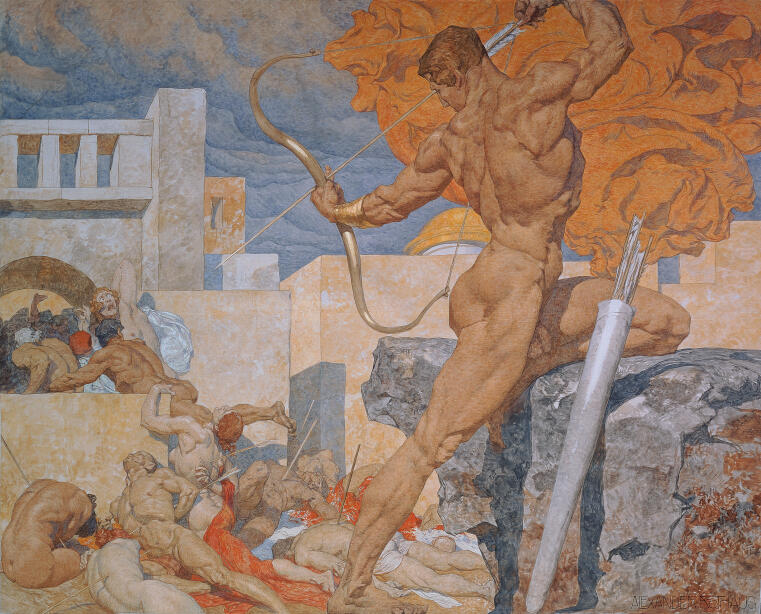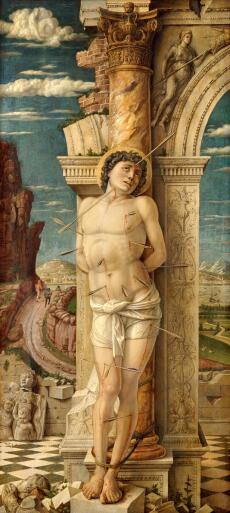Of plague arrows and miracles – of gods and saints
By historian Matthias Sandberg

The scene that Alexander Rothaug’s painting transforms into a powerful image full of drama and pathos is taken from the Homeric Iliad. The narrative that he chose was the story of how the plague came to the camp of the Achaians (Greeks) besieging Ilion (Troy) – in the form of plague arrows fired by the god Apollo. Apollo is depicted with such an arrow: he is preparing to fire the next arrow over those already struck down (a single arrow embedded in each back; the Iliad denotes such accuracy as Apollo’s preserve) at the Achaians, who are overcome with fear. The Apollo depicted here is merciless in his visiting of corruption on the people – it was the punishment of an avenging god.
The son of Zeus and Leto was angry with the leader of the Achaians: Agamemnon had repeatedly humiliated Chryses, a pious priest of Apollo’s. His iniquity meant the fall of the Greeks besieging Ilion, and retribution was swift: the avenging Apollo now visited his punishment on those who had unsuccessfully attacked Troy for ten years, and who were riven by strife and vanity. The plague therefore comes at the very beginning of the Iliad, and therefore also at the beginning of Western cultural history:
Which of the gods put strife between the chiefs,
That they should thus contend? Latona’s son
And Jove’s. Incensed against the king, he bade
A deadly pestilence appear among
The army, and the men were perishing.
For Atreus’ son with insult had received
Chryses the priest, who to the Grecian fleet
Came to redeem his daughter, offering
Uncounted ransom. In his hand he bore
The fillets of Apollo, archer-god,
Upon the golden sceptre, and he sued
To all the Greeks, but chiefly to the sons
Of Atreus, the two leaders of the host:—
“Ye sons of Atreus, and ye other chiefs,
Well-greaved Achaians, may the gods who dwell
Upon Olympus give you to o’erthrow
The city of Priam, and in safety reach
Your homes; but give me my beloved child,
And take her ransom, honoring him who sends
His arrows far, Apollo, son of Jove”.
Then all the other Greeks, applauding, bade
Revere the priest and take the liberal gifts
He offered, but the counsel did not please
Atrides Agamemnon; he dismissed
The priest with scorn, and added threatening words:—
“Old man, let me not find thee loitering here,
Beside the roomy ships, or coming back
Hereafter, lest the fillet thou dost bear
And sceptre of thy god protect thee not.
This maiden I release not till old age
Shall overtake her in my Argive home,
Far from her native country, where her hand
Shall throw the shuttle and shall dress my couch.
Go, chafe me not, if thou wouldst safely go”.
He spake; the aged man in fear obeyed
The mandate, and in silence walked apart,
Along the many-sounding ocean-side,
And fervently he prayed the monarch-god,
Apollo, golden-haired Latona’s son:—
“Hear me, thou bearer of the silver bow,
Who guardest Chrysa, and the holy isle
Of Cilia, and art lord in Tenedos,
O Smintheus! If I ever helped to deck
Thy glorious temple, if I ever burned
Upon thy altar the fat thighs of goats
And bullocks, grant my prayer, and let thy shafts
Avenge upon the Greeks the tears I shed”.
So spake he supplicating, and to him
Phoebus Apollo hearkened. Down he came,
Down from the summit of the Olympian mount,
Wrathful in heart; his shoulders bore the bow
And hollow quiver; there the arrows rang
Upon the shoulders of the angry god,
As on he moved. He came as comes the night,
And, seated from the ships aloof, sent forth
An arrow; terrible was heard the clang
Of that resplendent bow. At first he smote
The mules and the swift dogs, and then on man
He turned the deadly arrow. All around
Glared evermore the frequent funeral piles.
(Homer, Iliad, 1:8-52; translated by William Cullen Bryant)
The Iliad’s representation of the plague is the first reflection on epidemics in Western literature, and looking at how it interprets and explains them reveals one of the oldest and most fundamental principles of dealing with epidemics and disease in the ancient world: they were considered a divine punishment, an atonement for the sins of humankind. In addition, the work of the wrathful God reveals itself in a manifest symbol: the plague arrow.
The idea of the raging of the plague in the form of arrows bringing disease was not only a ‘symbolic’ approach to the ways unknown in the ancient world of how pathogens spread, but also a classical interpretation of this world: the idea of an arrow shot by a divine archer as a carrier of the infection was not only common in the early Greek thinking of the Homeric world. Numerous cultures of the Middle East and the Ancient Near East, where the Iliadic representation no doubt had its origins, know plague arrows and (plague) gods who sport bows and quivers among their attributes: Reschef, a Syrian-Palestinian deity, the Hittite Jarri, the Mesopotamian Nergal, the Egyptian Sekhmet, Yahweh, and not least the Christian god visited plague arrows on people.
But there was also protection against the arrows: the Iliadic Apollo is appeased after Agamemnon atones for his iniquity and grants Chryses the return of his stolen daughter. Carthian rituals and processions of atonement were able to appease the plague gods of the Ancient Near East and the Old Testament. There were and are numerous saints in the Christian faith whose assistance and protection could be invoked through prayer or ritual.

Saint Sebastian is a particularly fine example: the iconographic attributes of this Christian martyr include above all the arrows in his body, which, according to Christian tradition, stand for the vain attempt made by the persecutor of Christians, Diocletian (284-305), to execute the professing Christian. After learning that in Sebastian there was a Christian in his bodyguard who was also giving help to his persecuted brothers and sisters, the Emperor ordered his execution. Tied to a column, Sebastian was to be executed by archers. When the pious widow Irene finally wanted to remove his body, the miracle revealed itself to her: peppered with arrows, Sebastian was not dead.
The fact that Sebastian faced Diocletian a second time, confessed his faith once more, and then finally died is not relevant here. What is decisive is that Saint Sebastian was manifestly able to obtain protection from the plague and its plague arrows. The impressively elegant logic behind this conviction is now established: numerous Sebastian processions and Sebastian vows in connection with plague epidemics and bringing them to an end have been handed down from the Christian Middle Ages to the present day, and are still commemorated and performed today. But believers have turned to Sebastian for protection against disease not only in the form of prayer: small metal arrows (so-called Sebastian arrows) are worn as apotropaic amulets to ward off illness and epidemics.
In the end, the question remains as to how remote the symbol of the plague arrow as a carrier of disease and pestilence may seem to modern observers. Without a microscope at any rate, the invisible remains invisible even to the modern human, and many a message in connection with the reporting on corona and its consequences is reminiscent of Iliadic poetry: “terrible was heard the clang/Of that resplendent bow”.

